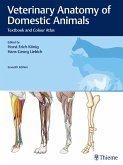The 6th edition of Jubb, Kennedy, and Palmer's Pathology of Domestic Animals continues the long tradition of this classic set of volumes as the most comprehensive reference book published on the topic of pathology of the common domestic mammals, with emphasis on disease conditions of cattle and small ruminants, swine, horses, dogs and cats. Using a body systems approach, recognized authorities in their fields provide overviews of general characteristics of the system, reactions to insult, and disease conditions broken down by type of infectious or toxic insult affecting the anatomical subdivisions of each body system. Since the publication of the 4th edition in 1993, much has changed. Disease agents, such as Bovine viral diarrhea virus (BVDV) type 2, Porcine reproductive and respiratory syndrome virus (PRRSV), Porcine circovirus 2, Hendra virus, and Leptospira spp., have emerged or further evolved. Molecular-based testing, including polymerase chain reaction (PCR) and in-situ hybridization, have allowed further understanding of pathogenesis of disease, and have greatly furthered our diagnostic capabilities.
- Updated content includes new and evolving pathogens and diagnostic techniques.
- Updated bibliographies give readers new entry points into the rapidly expanding literature on each subject.
- NEW! High-resolution color images clearly depict the diagnostic features of hundreds of conditions.
- NEW! Introduction to the Diagnostic Process chapter illustrates the whole animal perspective and details the approaches to systemic, multi-system, and polymicrobial disease.
- NEW! Coverage of camelids is now included in the reference's widened scope of species.
- NEW! Team of 30+ expert contributors offers the latest perspective on the continuum of issues in veterinary pathology.
- NEW! Expanded resources on the companion website include a variety of helpful tools such as full reference lists with entries linked to abstracts in Pub Med and bonus web-only figures.
- NEW! Full-color design improves the accessibility of the text.
'Much easier to read' was the important conclusion I came to, having spent a little time looking at the latest edition of 'Jubb and Kennedy'. The relatively simple step of increasing line spacing, and the use of subheadings and bullet points, makes reading any of the volumes of this edition much less daunting. The contents are arranged into 'body systems', and include aspects of the incidence and manifestation of different diseases in different tissues and organs. The improved format will ensure that it will continue to be used by pathologists, perhaps in particular, those undergoing training; some introductory sections bring together a lot of useful, as well as interesting, background information.
The Veterinary Record, October 2008
The Veterinary Record, October 2008








